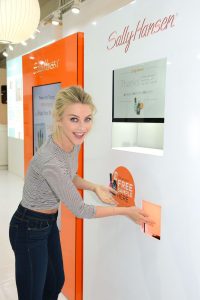You walk into a retail store, and you’re drawn to a black shirt that’s a little different than your current style. But you like it. You like it a lot, actually, and you think about buying it. Unfortunately, you promised yourself you wouldn’t buy any more black — your closet looks like the Grim Reaper resides there. You don’t see the shirt hanging in any other colors and almost turn away from the rack until a 6-by-6-inch sign catches your eye.
It’s an image and the name of that shirt you like a lot. By this time, an employee comes over and tells you that you can see the shirt in all the available colors simply by raising your phone to the sign and letting your phone sensors scan it. Not only do additional colors digitally appear on your cell screen, but you even have access to customer reviews and the option to purchase the item online right from your device.
You’ve never had such an interesting (and convenient) shopping experience, and you’re hooked.
Welcome to your new normal: augmented reality.
Augmented reality, by definition, is “a technology that superimposes a computer-generated image on a user’s view of the real world, thus providing a composite view.”
Not to be confused with virtual reality, which completely transports a person into a different “world” via special eyewear, augmented reality instead adds digital components to a person’s actual reality. It’s a blend between what’s real and what’s not, and albeit seemingly futuristic, it’s the buying experience of today.
Melissa Gonzalez is a pop-up shop expert. As a former Wall Street executive and the founder of pop-up shop agency The Lion’esque Group, Gonzalez has been adding pop-ups to retailers’ marketing strategies since 2009, way before the pop-up sensation became mainstream.

Last spring, Gonzalez built a pop-up for Penguin Random House in San Juan, Puerto Rico, to test out the market. Integrating technology into these shopping experiences encourages the customer to interact, thus becoming more invested in the brand and their products. In the pop-up, Gonzalez and her team incorporated an “endless aisle experience” for books; there were a browse bar and a recommendations center. These installments ultimately gave Gonzalez insight on the fact that the San Juan market was a top-seller for Borders, and this pop-up was providing the people access they haven’t had since Borders closed its doors in 2011.
The PRH pop-up also featured an augmented reality display that enabled customers to insert their faces into book covers. While this seems like a fun, interactive activity for the customers (and it was!), it really served to gather data on the types of book covers people were drawn to. A win-win.
Gonzalez says augmented reality, as opposed to virtual reality, works in retail and other similar markets because it keeps the buyer grounded in the environment. You want your customer to stay in the here-and-now, and VR removes them from the buying environment. But AR doesn’t just work… It’s the key to sales. The market is currently worth $600 million, and it’s projected to grow to $30 billion in 2020.
AR is a big deal.
“Augmented reality allows for a more immersive learning experience,” Gonzalez explains. “We all learn from sensorial experiences, so this is captivating a visual sensory. Any type of interaction we’re all having with technology, it’s a chance for brands to learn.” The more the brands can learn about their customers, the better they can turn conversions in the future.

As far as trending strategies go, “RFID is a huge one,” Gonzalez says. “I think more and more, you’re going to see products tagged with RFID tagging so that there’s more communication within the store.”
Of course, before any brand decides to adopt new technology, it’s imperative they have a scope and goals before taking the plunge. Gonzalez says, “Think about your strategy before you invest in any tech. They’re all dual-purpose and serve to increase engagement and to learn. Ask yourself, ‘What am I trying to get out of this?’ There’s always the cool factor of technology, but if it doesn’t make sense to customers, you’re not getting the most out of it. That’s why it’s important to have that starting scope.”
Because AR melds the real with the unreal, stores are still using displays and signs to create real-life experiences for customers. Printing becomes a necessary arm to this new reality, innovating the industry to keep up with tech’s fast pace.
And there is a unique opportunity for printers to get in on the digital action. Because AR melds the real with the unreal, stores are still using displays and signs to create real-life experiences for customers. Printing becomes a necessary arm to this new reality, innovating the industry to keep up with tech’s fast pace.
…For now, anyway.

